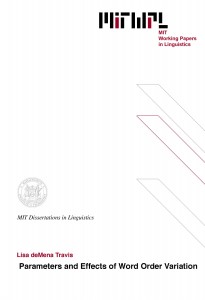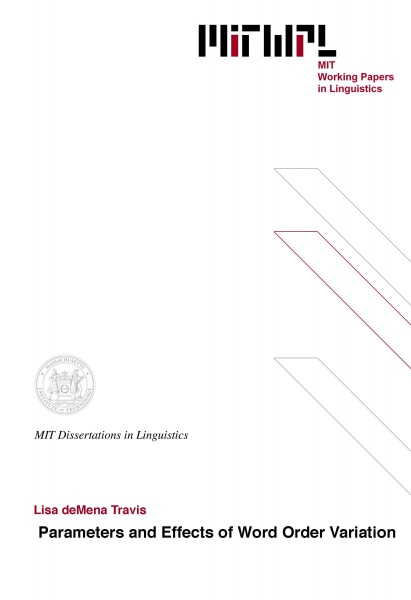Parameters and Effects of Word Order Variation
L. D. Travis, 1984
Paramters and Effects of Word Order Variation
Lisa deMena Travis
June 1984
Abstract
This thesis investigates different issues raised by the problems of language specific word orders. The aim of Chapter 2 is to replace Phrase Structure Rules which stipulate the order of constituents. The Domain Adjacency Condition (DAC) predicts the order of non-head constituents in relation to one another, while the parameters of the direction of case assigned and O-role assignment, together with the head-initial/head-final parameter, establish the order of non-head constituents in relation to the head. The parameter of direction of predication accounts for the position of a subject in relation to its predicate. Word order typology is now more detailed because the S-V-O type of description is expanded to include the INFL node, subcategorized PPs (PP1s) and non-subcategorized PPs (PP2s), and it is more restrictive because languages must fit into such a parametric description.
Chapter 3 presents an account of Germanic word order which relies heavily on the INFL node in both the synchronic and diachronic characterization. The Head Movement Constraint is introduced to account for the movement of V into INFL, and INFL into COMP. In some historical speculating, it is shown that contradictory demands on INFL create tension in grammatical systems and promote reanalysis of d-structures.
Chapter 4 extends the notion of proper government to include the proper government of a subject NP by an adjacent VP. This account relies on the DAC and a functional definition of proper government. It is shown that this type of proper government, complement government, explains not only es-insertion in Germanic languages, but also extraction facts in Italian and Chamorro, and pro-drop facts in Italian and Irish. It is further noted that while the ECP requires the notion of complement government, the CED still requires the more restricted notion of proper government, lexical government.
Chapter 5 presents several problems related to pleonastics including the interaction of pleonasitcs with verb agreement, case assignment, and chain formation. It is claimed that there are two types of pleonastics, the I-type and the T-type, and that these represent a hierarchy of features which divide pleonastic constructions in predictable ways.
Thesis supervisor: Noam Chomsky
Title: Institute Professor
Table of Contents
Chapter 1 Introduction 9
1.1 Introduction to Government Binding Theory 9
1.1.1 Grammatical model 9
1.1.1.1 D-structure 10
1.1.1.2 S-structure 12
1.1.1.3 Predication 13
1.1.1.4 PF 15
1.1.1.5 LF 15
1.1.2 Projection principle 16
1.1.3 Government 18
1.1.3.1 C-command 18
1.1.3.2 Proper government and the ECP 20
1.1.4 Government and PRO 21
1.1.5 Case theory 22
1.1.5.1 Case filter 22
1.2 Introduction to the thesis 23
1.2.1 Chapter 2 23
1.2.2 Chapter 3 24
1.2.3 Chapter 4 24
1.2.4 Chapter 5 26
1.2.5 Chapter 6 27
Chapter 2 Word order parameters and typology 28
2.1 Constituents of the verb phrase 39
2.1.1 Facts 40
2.1.1.1 Archaic Chinese 40
2.1.1.2 Modern Mandarin 41
2.1.2 The controversy 43
2.1.3 Paramters in Chinese 44
2.1.3.1 Archaic Chinese 44
2.1.3.2 Modern Mandarin 45
2.1.4 L&T’s speculations 56
2.1.4.1 Preposed objects 56
2.1.4.2 Case parameter 56
2.1.5 Conclusion 59
2.1.6 Postscript 61
2.2 Huang’s analysis 62
2.2.1 Problems for the Case analysis 63
2.2.1.1 Adjectives 63
2.2.1.2 PF adjacency 65
2.2.2 Problems for Huang’s analysis 68
2.3 Branching 71
2.3.1 Ordering 73
2.3.2 Constituency 77
2.3.2.1 Move-a 77
2.3.2.2 Pronominalization 80
2.3.2.3 Co-ordination 84
2.3.3 Summary 85
2.4 Contituents of INFL 87
2.4.1 NP and INFL 88
2.4.2 INFL and VP 89
2.4.3 NP and VP 90
2.5 Word order and typology 92
2.5.1 Steele 93
2.5.2 Possible counterexamples 95
2.5.2.1 Diola-Fogny 96
2.5.2.2 Chinese 99
2.5.2.3 Chorti 101
2.6 Discussion 103
2.6.1 Summary 103
2.6.2 Questions 104
Chapter 3 Word order in Germanic languages 108
3.1 German and Dutch: the accepted analysis 110
3.2 Yiddish 114
3.2.1 Yiddish is not INFL-final 114
3.2.2 Yiddish is not INFL-initial 115
3.2.2.1 Pronouns 117
3.2.2.2 Extraction 118
3.2.3 Yiddish is S-I-VP 119
3.3 German revisited 120
3.4 Theoretical motivations 129
3.4.1 Movement of heads 130
3.4.2 INFL movement 135
3.4.2.1 INFL movement: Left 135
3.4.2.2 INFL movement: Right 139
3.4.3 Summary 145
3.5 Historical speculations 146
3.5.1 Assumptions 146
3.5.1.1 INFL and V adjacency 147
3.5.1.2 Case adjacency 147
3.5.1.3 Unity of case assignment direction 147
3.5.1.4 Inconsistency 148
3.5.2 Germanic languages 148
3.6 Conclusions and typological speculations 155
Chapter 4 VP government 159
4.1 Es-insertion 162
4.1.1 Facts 162
4.1.1.1 German 163
4.1.1.2 Yiddish 164
4.1.2 Safir’s analysis 165
4.1.3 VP government 166
4.2 Government 169
4.2.1 Identification 170
4.2.1.1 Gap identification 173
4.2.1.2 Recoverability of features 174
4.2.2 VP government 175
4.2.2.1 Formal definition 178
4.2.2.2 Identification vs. features 184
4.2.3 Structural government 187
4.2.4 Empirical consequences 197
4.2.4.1 Italian 197
4.2.4.2 INFL+V peripheral languages; Chamorro 200
4.2.4.3 Irish and null subject languages 206
4.3 Revision of the CED 209
4.3.1 Spanish 210
4.3.2 Chinese 211
4.3.3 Welsh 212
4.3.4 CED – revised 213
4.4 Conclusion 214
Chapter 5 Pleonastics 216
5.1 The hierarchy 217
5.1.1 Justification for the hierarchy 218
5.2 Pleonastics: language specific 226
5.2.1 Empty subjects 227
5.2.1.1 INFL features 229
5.2.2 Optional pleonastics 231
5.2.3 I-type vs. T-type 232
5.2.4 Irish 234
5.3 T-type pleonastics 237
5.3.1 Reviews 237
5.3.2 T-type pleonastics are Case 241
5.3.3 Analysis 247
5.4 I-type pleonastics 252
5.4.1 ES vs. ES/O in German 253
5.4.2 HET vs. ER in Dutch 255
5.4.3 Analysis 257
5.4.3.1 Passive 258
5.4.3.2 Argument S’s 261
Chapter 6 Conclusion 268
6.1 Domains 268
6.2 Importance of INFL 270
6.3 Word order effects 272

